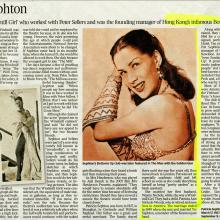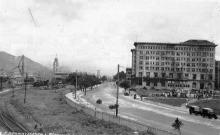This picture shows the Guinea (aka Napier and elephant) grass, which was grown in trenches 18” apart. The ecological cycle was such that the cattle ate the grass, processed and dumped it out the other end. This was then stored, liquified and pumped up the hills to form fertilizers for the grass. This grew only in the summer months. Whatever was left (there was always surplus) was then transferred into the silos (of which there were originally 6) - the conical roof and tower of one can be seen in this picture, to the right of the white cowshed (source DF 1980s Annual Report). On one occasion several officious Lands Department officials were apparently conducting an inspection, when the pump accidentally got turned on, causing much noise and expletives regarding people’s mothers. The origins of the grass in Pokfulam has not yet been fully established, but is believed to have been originally brought in from India, which in turn got the grass from East Africa (cultivated by a Major Napier). New strains were introduced, reputedly from Malaysia. At one time there was a plan (circa 1960s) to plant another form of crop called Pokfulam Gold, which the cows would have liked. But this would have attracted the interest of the police...and any passing hippy backpacker. Hence it was decided not to proceed (source: last farm manager).
Dairy Farm
Primary tabs

Submitted by Wallydog
Date picture taken (may be approximate):
Wednesday, June 1, 1983
Gallery:
Connections:
- Dairy Farm shows Place The 'Dairy Farm' farm, Pokfulam [1886- ]
- Dairy Farm shows Place Silage silo, near modern-day Fu Yat Yuen [????-????]




Comments
Thanks for the extra
Thanks for the extra information about Dairy Farm. Do you know if the cows were ever taken out to pasture, or did they live in these sheds & pens with food brought in to them?
Mostly kept in the paddocks
Mostly kept in the paddocks.There weren’t pastures as we know them today. However there is some evidence (1919 manual) to show that pastures of sorts existed during the early years ie first two decades.
Paddocks
Thanks for the extra info.
Further up you mentioned the origins of the grasses. Have you had a chance to see the annual reports of the "Botanical and afforestation Department" ? They talk about the introduction of new plants, so may have something about the grasses.
Thnaks will investigate.
Thanks will investigate.
They have copies of the
They have copies of the reports available at the HKGRO website.
Here's an extract from the report for 1907:
Fodder.—A quantity of an Australian fodder grass, supposed to have good drought resisting powers was introduced and sown in the Government Nursery at Sookunpo in 1906. It grew well and was tried in February of this year by the Colonial Veterinary Surgeon on bullocks at Kennedy Town. Although a good deal withered the cattle ate it greedily and Mr. Gibson asked for some plants to try side by side with Guinea Grass the usual winter fodder in use here. Plants were sent and I now have a report that it has grown well though it is not comparable either in bulk or quickness of increase with Guinea Grass. Further trials however will be made.